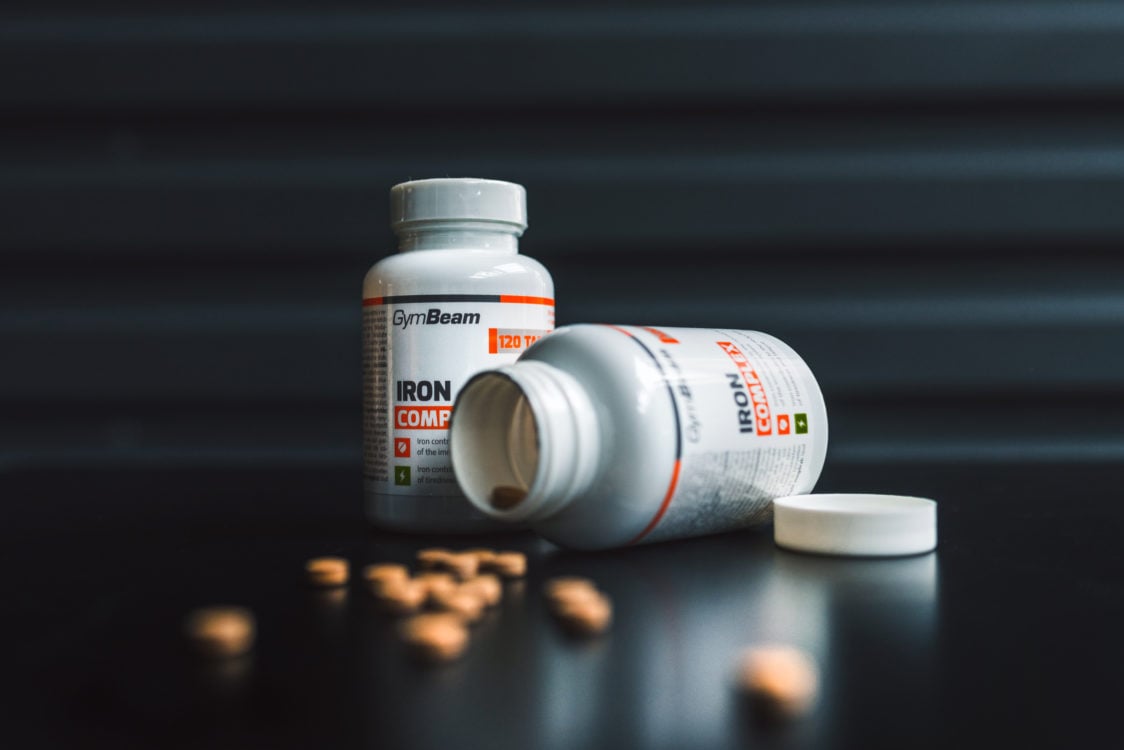Table of Contents
You’ve probably heard how important vitamins are in our diet. They have an impact on immunity, health, appearance and other aspects of life. Unfortunately, however, it often happens that vitamins are in the spotlight, and they somehow overshadow other important micronutrients. These also include mineral substances (often referred to as minerals). But they certainly don’t play a minor role in our lives. It’s the other way around. Hundreds of metabolic reactions depend on them, which would not take place without the necessary amount of minerals. Therefore, in today’s article, we decided to focus on minerals and their impact on the body. At the same time, you will learn how much you should consume each day and how to detect a deficiency or possible excess of minerals in the body.
What are mineral substances anyway?
Mineral substances (often referred to as minerals) are elements that are naturally found mainly in soil or water and have a fundamental role in our lives. They are essential for the proper functioning of metabolic transformations and reactions in the body. The lack of which can negatively affect mental and physical health.
They affect the nervous system, immunity, musculoskeletal system, energy metabolism and cognitive functions, such as memory and concentration. They are also important for maintaining optimal testosterone levels and reproductive functions. Low levels can be manifested, for example, by fatigue, poor quality of nails, hair, skin and many various health problems. Our body needs different amounts of certain minerals. This is generally in the range of a few tens, to hundreds of milligrams. [1–4]
You will learn about the following minerals in the article:
Where do the minerals come from?
As we discussed above, minerals are given to us by planet Earth itself. We can then ingest them into the body quite easily, by consuming plant or animal products. Soil and water naturally contain minerals, which plants take from to their advantage. Various animals then eat the plants, thereby obtaining these valuable substances. So, you can obtain these micronutrients by eating both plants and animal products. However, if you are unable to cover the necessary amount of these substances within a diet, you are at risk of a deficiency. [1–4]
Supplements can help us with the intake of these basic nutrients. Reaching for them makes sense, for example, when your diet does not contain enough fruits, vegetables and other whole foods, which are the main source of key minerals and other important micronutrients. But they are also popular among people who, for whatever reason, eliminate different food groups. These may include, for example, cereals, baked goods, legumes, meat, dairy products and the like. Mineral supplements are also often sought after by people on a weight loss diet who may not be able to cover enough micronutrients through diet due to low intake.
What is malabsorption syndrome?
Speaking of mineral intake, we need to explain this important and perhaps little-known term – malabsorption syndrome. This is a condition in which our body is unable for some reason to absorb sufficient amounts of minerals and other micronutrients you receive. This problem is associated with some diseases. Often these are various disorders of the gastrointestinal tract (digestive system), such as Crohn’s disease, coeliac disease, pancreatitis or ulcerative colitis. It may also occur in people with a stoma (e.g., an outlet from the large intestine). However, malabsorption can be a side effect of other chronic diseases such as HIV, anorexia, cancer and alcoholism. [5]
How do we classify minerals?
- Macrominerals – they are specific in that their daily intake should be higher than 100 mg.
- Microminerals – they are specific in that their intake should be in the range of 0 – 100 mg.

What affects the overall need for minerals?
However, during intake, it is also necessary to bear in mind that our daily needs for minerals are influenced by several factors, including: [2]
- sex
- age
- medications
- energy intake
- stress
- level of physical activity
- pregnancy and menstruation
- genetics
- illness
- growth and development
You might be interested in these products:
Minerals: functions, sources, recommended daily intake, symptoms of deficiency and excess
In order to understand the importance of minerals, we will look in more detail at their function in the body and the sources from which they can be drawn. Of course, we won’t deprive you of information on how to identify an excess or deficiency of individual minerals. For convenience, we have also added recommended intake values.
We outline the daily recommended intakes of nutrients of particular interest according to the methodologies of the European Food Safety Authority (hereafter EFSA) and compare these values with the latest reference values of the German -speaking Nutrition Society (hereafter DACH). We always indicate the amount that is recommended for an average adult.
Basic information on macro mineral substances
Our body usually needs macrominerals in larger quantities. As a rule, it is 100 or more milligrams. Important macromineral substances include calcium, phosphorus, magnesium, sodium, potassium, chlorine and sulphur.
Calcium
You’ve probably heard of calcium, especially in relation to the health of bones and teeth. This is because it forms a large part of their structure. Up to 98% of this mineral is found in the bones, where it keeps the bone tissue strong and supple. It also has an effect on our movement. Therefore, its intake is particularly important for athletes or older people, who naturally experience thinning bones with age and an increased risk of developing osteoporosis. This also applies to menopausal women whose production of oestrogen is reduced, which results in lower calcium absorption.
Feel like you’ve heard similar risks about vitamin D? It’s not a coincidence. Without vitamin D, calcium would not be able to be absorbed into the body. Without exaggeration, we can say that both of these micronutrients are crucial to bone health. This is why, for example, they often appear together in food supplements. However, in relation to bone health, we should mention the role of vitamin K, which is also very important. [1–4] [6–8] [9–10]
You are especially at risk of calcium deficiency if you do not consume enough dairy products and other foods rich in this mineral. Plant-based milk, which is fortified with calcium, among other things, can help you with calcium intake.
- Functions: it is essential for the transmission of nerve impulses, muscle contraction and proper blood clotting. In addition, it contributes to the construction of teeth and bones. This is why it is popular in people who are trying to prevent osteoporosis (thinning of the bones). In addition, it also affects the transmission of nerve impulses, the proper functioning of digestive enzymes, blood clotting, muscles and also contributes to proper metabolism important for energy production.
- Sources: dairy products (yoghurt, mozzarella, milk), sardines, soy milk, tofu, salmon, spinach, soybeans, cabbage, chia seeds.
- Recommended daily allowance according to EFSA: 1000mg
- Recommended daily allowance according to DACH: 1000mg
- Signs of deficiency: decreased bone strength, rickets in children, osteomalacia (softening of the bones), muscle spasms and muscle weakness.
- Signs of excess: soft tissue calcification, kidney stones, abnormal heart and brain function, excessive thirst, stomach pain and indigestion, muscle weakness, fatigue, anxiety.

Phosphorus
Phosphorus is found naturally in bones, teeth, DNA and RNA. However, it is also part of the cell membrane and ATP, which serves as an energy source. Many foods contain phosphorus in the form of highly absorbable phosphate and phosphate esters. However, in some sources, such as various seeds, it is in the form of phytic acid, which is not so readily available to the body. We don’t have an enzyme called phytase in our intestines to help us absorb it. Therefore, it is better to look for these better digestible resources. [1–4] [6–8] [11–12]
- Functions: as well as calcium, it affects the maintenance of healthy teeth, bones and proper metabolism important for energy production. In addition, it also helps with the proper functioning of cell membranes.
- Sources: dairy products, poultry, fish, eggs, nuts, seeds, legumes, potatoes, asparagus.
- Recommended daily allowance according to EFSA: 550mg
- Recommended daily allowance according to DACH: 700mg
- Deficiency effects: phosphorous deficiency is very rare and include muscle and respiratory weakness, bone pain, increased risk of infection, paraesthesia, confusion
- Symptoms of excess: muscle cramps, bone pain, tingling, fatigue, shortness of breath
Magnesium
Magnesium is one of the most important minerals. It participates in more than 300 biochemical reactions in the body, which could not take place without it. The adult body contains approximately 25g of magnesium, with approximately 60% in the bones and the remainder in soft tissues.
Since it, like calcium, has been linked to the development of muscle cramps, athletes in particular focus on increasing their intake. During exercise, magnesium and other electrolytes are lost via sweat from the body, and therefore their levels may decrease. This can be avoided, for example, by consuming ionic drinks or electrolyte tablets. [1–4] [6–8] [13–14]
- Functions: affects the proper functioning of the muscles and nervous system. Just like calcium is important for the transmission of nerve impulses and muscle contraction. However, it also contributes to reduced fatigue and exhaustion, electrolyte balance, proper mental function and normal protein synthesis. In addition, it is known to help maintain healthy teeth and bones.
- Sources: pumpkin seeds, chia seeds, almonds, spinach, cashew nuts, peanuts, potatoes, almonds, dark chocolate, tempeh.
- EFSA recommended daily intake: 300 mg for women, 350 mg for men
- Recommended daily intake according to DACH: 300 mg for women, 350 mg for men
- Signs of deficiency: fatigue, weakness, moodiness, headache, nausea, loss of appetite, muscle cramps, risk of deficiency increases if alcohol is consumed excessively.
- Signs of excess: occurs in people with severe kidney or liver disease, presents with nausea, vomiting, neurological problems, headache.
If you want to learn more about magnesium, you shouldn’t miss our article Cramps, Fatigue, Irritability or Sleep. What Else Does Magnesium Affect?

Sodium
Sodium, like magnesium, is a very important mineral especially for athletes. It is the main cation of extracellular fluids and, together with potassium, contributes to the body’s balanced water management. As sodium levels drop, the familiar cramps and dehydration can occur during sport, which is then likely to have a negative effect on your performance. This is also the reason why endurance athletes supplement sodium during exercise.
Its impact on the proper functioning of the body is thus unquestionable. At the same time, we must not overdo it, because its excess is associated with high blood pressure. [1–4] [6–8]
- Functions: contributes to optimal hydration of the body and maintenance of blood homeostasis, is necessary for nerve and muscle activity.
- Sources: table salt
- EFSA recommended daily intake: 2000 mg
- Recommended daily intake according to DACH: 1500 mg
- Signs of deficiency: low blood pressure, dehydration, muscle cramps.
- Signs of excess: high blood pressure, water retention, swelling, nausea, vomiting, diarrhoea, abdominal cramps.
Potassium
Potassium is found in all body tissues and is essential for normal body function. Together with sodium, they contribute to maintaining optimal water ratios inside and outside cells. This is important for optimum hydration of the body and the proper progression of all important biochemical reactions in the body. These usually take place in water. As with other electrolytes, we lose potassium through our sweat during sporting activities. This makes it ideal, especially during prolonged activity when we sweat more, to replenish it with electrolyte supplements. [1–4] [6–8] [15]
- Functions: contributes to the maintenance of normal blood pressure, proper muscle and nervous system function.
- Sources: apricots, lentils, beans, soybeans, prunes, pumpkins, potatoes, milk, bananas, cereals and nuts.
- EFSA recommended daily intake: 3500 mg
- Recommended daily intake according to DACH: 4000 mg
- Signs of deficiency: cardiac arrhythmias, high blood pressure, muscle cramps, glucose intolerance, kidney stone formation, loss of bone mass.
- Signs of excess: tingling or numbness of the limbs, muscle weakness, nausea, vomiting, diarrhoea, cardiac arrhythmias.

Chlorine
Chlorine is a mineral found in virtually every food in varying amounts. Its higher content can be found especially in highly processed foods. This is because they often have a higher salt content. This is also the reason why, as a rule, we do not have to worry about a lack of chlorine in the body. It is one of the electrolytes, that we lose a certain amount of through sweat. Therefore, we should focus on its intake in the case we undertake a lot of sports. [1–4] [6–8] [16–17]
- Functions: contributes to proper digestion by producing hydrochloric acid in the stomach. It is important for maintaining fluid balance.
- Sources: table salt
- EFSA recommended daily intake: 3100 mg
- Recommended daily intake according to DACH: 2300 mg
- Signs of deficiency: hypochloraemic alkalosis – related, for example, to the administration of diuretics or prolonged vomiting, in which large amounts of chloride anions are lost.
- Signs of excess: high blood pressure, fluid retention, muscle weakness, cramps, tingling, irregular heart rate.
Sulphur
Sulphur is an important component of two essential amino acids, cysteine and methionine, which are essential for the production of proteins. But it is also part of taurine and is found in all cells of the human body. In higher concentrations, however, it can be found, for example, in skin, nails, hair, joints and bone mass. It generally helps the tissues to be strong and supple. In addition, the body needs sulphur to create and preserve DNA. [1–4] [6–8] [18]
- Functions: it participates in many processes in the body. It is important for supporting the natural detoxification of the liver, collagen synthesis and is also part of the antioxidant system.
- Sources: turkey, beef and chicken, fish, eggs, nuts, seeds, legumes, chickpeas, couscous, vegetables.
- EFSA recommended daily intake: no recommended daily intake for sulphur has been established.
- Recommended daily intake according to DACH: no recommended daily intake for sulphur has been established.
- Signs of deficiency: no deficiencies recorded in the developed Western world.
- Signs of excess: diarrhoea, inflammatory bowel disease, ulcerative colitis.
Basic information on micromineral substances
Microminerals (trace elements) our body usually needs in smaller quantities. As a rule, it is 0 to 100 milligrams. Important micromineral substances include iron, zinc, copper, iodine, fluorine, chromium, cobalt, selenium, manganese, molybdenum.
Iron
Iron is a basic component of red blood cells (erythrocytes) that carry oxygen from the lungs to all tissues in the body. It is also part of myoglobin, another protein found in some muscles, where it provides oxygen to muscle cells. Iron is also essential for physiological growth, neurological development and the proper functioning of cells and hormone production. Its deficiency (anaemia) may occur, for example, in women who have a heavy menstrual period and lose larger amounts of blood. [1–4]
In food, iron has two forms called heme and non-heme. Plant sources primary contain the non-haem form. Moreover, animal sources contain both forms. [1–4] [6–8] [19–21]
- Functions: affects cognitive function, proper red blood cell production, oxygen transfer and optimal immune function. It also helps to reduce fatigue, exhaustion and also plays a role in the process of cell division and energy metabolism.
- Sources: beef liver and other offal, red meat, oysters, white beans, chocolate, lentils, egg yolks, leafy vegetables, legumes.
- EFSA recommended daily intake: 16 mg for women, 11 mg for men
- Recommended daily intake according to DACH: 10 – 15 mg for women, 10 mg for men
- Signs of deficiency: paleness, fatigue, anaemia, decreased immunity.
- Signs of excess: diarrhoea, abdominal pain, problems with blood clotting, vomiting, low blood pressure and problems with proper liver function. But excesses do not often appear. For this to happen, a person would have to eat approximately 20 mg of iron per kg of their body weight.

Zinc
Zinc is one of the minerals needed for more than 300 enzymes in our body. You can get it from a variety of sources, but animal sources have better bioavailability. Plant sources may contain zinc compounds that are less easily absorbed. This is a problem because zinc is particularly important for maintaining overall health. It helps fight viruses and bacteria that can attack our bodies. It is also needed for the production of proteins, DNA, genetic material in all cells and also to maintain normal testosterone levels in the blood. [1–4] [6–8] [22]
- Functions: helps protect cells from oxidative stress, maintain healthy skin, nails, hair, bones, normal testosterone levels in the blood and also contributes to the proper function of the immune system. In addition, it also affects fertility and reproductive function. It helps with proper metabolism of vitamin A and maintaining good vision. However, it also affects cognitive function.
- Sources: oysters, beef, pork and chicken, lobster, beans, yoghurt.
- EFSA recommended daily intake: 7.5 – 12.7 mg for women, 9.4 mg for men
- Recommended daily intake according to DACH: 7 – 10 mg for women, 11 – 16 mg for men
- Signs of deficiency: growth retardation, damage to skin, nails, poor genital function, reduced immunity, loss of taste, hair, dry eyes.
- Signs of excess: copper deficiency (excessive amounts of zinc (non-physiological) may reduce its absorption), nausea, vomiting, diarrhoea.
If you want to read more about zinc, you should not miss our article Zinc: What is It Good for, What Causes a Deficiency and What the Best Sources Are?
Copper
Copper is an important substance that is involved in many physiological processes in the body. It affects the immune system, for example, and as it is an antioxidant, it also helps protect cells from oxidative stress. In addition, it is also involved in collagen formation and protein synthesis. Due to its mechanism of action, copper also affects both the skin and hair colour. It is thus an important substance for anyone who strives for healthy and tanned skin or quality hair with a natural colour shade. [1–4] [6–8] [23]
- Functions: it is important for maintaining healthy connective tissue, hair, skin pigmentation and immune function. In addition, it helps protect cells from oxidative stress. Copper is one of the minerals that affect the functioning of the nervous system.
- Sources: beef, oysters, chocolate (cocoa), potatoes, shiitake mushrooms, cashews, crab meat, sunflower seeds, turkey meat, tofu.
- EFSA recommended daily intake: 1.3 mg for women, 1.5 mg for men
- Recommended daily intake according to DACH: 1 – 1.5mg
- Signs of deficiency: impaired haematopoiesis (blood formation), immune system, hair growth, low white blood cell count, loss of hair and skin colour due to lack of melanin (hypopigmentation).
- Signs of excess: nausea and vomiting, abdominal pain, diarrhoea, liver damage, but excess is very rare in the developed world.

Iodine
Iodine is a trace element that naturally occurs in foods, but is also added to various types of salt. It is an essential component of thyroid hormones thyroxine (T4) and triiodothyronine (T3), which regulate many biological reactions and thus affect metabolic rate. They affect, for example, protein synthesis and enzyme activity. However, they are also necessary for the proper development of the skeletal system, nervous system, foetuses and infants. It is also thought to have an effect on the immune system. Iodine is rarely found as an element, it is more often found in the form of salt, i.e., iodide. [1–4] [6–8] [24]
- Functions: affects cognitive function, the nervous system and maintains healthy skin. In addition, it contributes to the proper production of thyroid hormones and its optimal functioning.
- Sources: nori seaweed, iodised salts, whole grain breads, cod, yoghurt, oysters, milk.
- EFSA recommended daily intake: 150μg
- Recommended daily intake according to DACH: 150 – 200ug
- Signs of deficiency: rough skin, poor hair quality, apathy, impaired growth and neurological development, decreased thyroid function (hypothyroidism).
- Signs of excess: burning of the mouth, throat, stomach, diarrhoea, enlargement of the thyroid gland (goitre).
Fluorine
Fluorine is most commonly found in the body in the form of fluoride. Most of what we have in our body comes from water, food and toothpaste. Approximately 99% of fluoride is found in teeth. Therefore, there is a direct connection between the intake of this element and the quality of teeth and their enamel. [1–4] [6–8] [25]
- Function: it is particularly important for the proper mineralisation of teeth.
- Sources: toothpaste, black tea, coffee, water, shrimp, oatmeal, potatoes, rice.
- EFSA recommended daily intake: 2.9 mg for women, 3.4 mg for men
- Recommended daily intake according to DACH: 3.1 mg for women, 3.8 mg for men
- Signs of deficiency: tooth decay, poor placement of calcium in the bones.
- Signs of excess: dental enamel calcification (spots on the enamel) may occur with long term excess intake.

Chromium
Chromium is a trace element that can play a role in the metabolism of carbohydrates, lipids and proteins by potentially influencing the action of insulin. However, chromium can also have antioxidant effects. This would mean that it helps protect cells from oxidative stress and free radicals. [1–4] [6–8] [26]
- Functions: it affects the proper metabolism of macronutrients in the body and also contributes to the maintenance of normal blood glucose levels.
- Sources: grapes, brewer’s yeast, oranges, beef and turkey meat, bananas, liver, seafood, whole grains, cheese.
- EFSA recommended daily intake: no recommended daily intake for chromium has been established.
- Recommended daily intake according to DACH: 30 – 100µg
- Signs of deficiency: decreased glucose tolerance, delayed growth.
- Signs of excess: may increase the risk of DNA damage.
Cobalt
What’s interesting about cobalt is that it’s part of vitamin B12 (cobalamin). Therefore, this element also forms part of the name of this vitamin. Cobalamin is very important in our body because it contributes to the proper functioning of the immune system, our mental health and the nervous system. In addition, it also affects the production of red blood cells and also plays a role in the process of cell division. [1–4] [6–8] [27–28]
- Function: affects the proper functioning of the body.
- Sources: fish, nuts, green vegetables (broccoli, spinach), oats.
- EFSA recommended daily intake: no recommended daily intake for cobalt has been established.
- Recommended daily intake according to DACH: no recommended daily intake for cobalt has been established.
- Signs of deficiency: paleness, weakness, fatigue, loss of appetite, weight loss and subsequent poor growth, shortness of breath, dizziness, tingling of the extremities.
- Signs of excess: in excess could affect male fertility and heart function.
Selenium
Selenium is a powerful antioxidant and also a trace element that our body cannot do without. It is a component of more than 20 selenoproteins, which are involved in reproduction, thyroid hormone metabolism or DNA synthesis. In addition, they help protect cells from oxidative stress and infection.
Selenium generally exists in two forms. Specifically, these are organic (selenomethionine and selenocysteine) and inorganic (selenate and selenite). Both of these forms are good sources of selenium. We should be wary when ingesting it, though. It’s actually very easy to get too much into your body. For example, Brazil nuts will give the body approximately 540µg of selenium. [1–4] [6–8] [29]
- Functions: contributes to proper spermatogenesis (formation of male sex cells – sperm), maintaining healthy hair, nails, optimal functioning of immunity, thyroid glands, and in addition helps protect cells from oxidative stress.
- Sources: Brazil nuts, tuna, halibut, sardines, ham, prawns, beef and turkey meat, cottage cheese, rice, milk, eggs.
- EFSA recommended daily intake: 70µg
- Recommended daily intake according to DACH: 60µg for women, 70µg for men
- Signs of deficiency: reduction of antioxidant and immune responses.
- Signs of excess: skin problems, brittle hair and nails, fatigue, garlic odour from the skin and breath.

Manganese
Manganese is a basic trace element that is a cofactor of many enzymes. As a result, it is involved in the metabolism of amino acids, cholesterol, glucose and carbohydrates. However, it also affects bone formation, immunity and reproductive function. Manganese is absorbed in the small intestine via the active transport system. Its absorption can be reduced by phytates, which are naturally found in foods, iron, magnesium and calcium. [1–4] [6–8] [30–31]
- Functions: helps with optimal metabolism which is important for energy production and maintaining healthy bones. In addition, it contributes to the protection of cells from oxidative stress and affects the normal production of connective tissues.
- Sources: mussels, hazelnuts, pecans, brown rice, oyster, chickpeas, spinach, pineapple.
- EFSA recommended daily intake: 3 mg
- Recommended daily intake according to DACH: 2–5 mg
- Signs of deficiency: so far, no consistent scientific data are available that clearly describe the impact of deficiency of this mineral. However, limited scientific evidence mentions bone demineralisation, skin rash, increased premenstrual pain in women or mood swings as possible manifestations.
- Signs of excess: excessive intake of manganese has not been shown to cause toxicity, but can occur in people who work, for example, as welders or miners and are often exposed to manganese dust. It manifests as irritability, hallucinations, libido disorders or coordination problems.
Molybdenum
Molybdenum is an essential trace element. It is a structural component of molybdopterin, which is a cofactor needed for the function of four enzymes. These metabolise amino acids containing sulphur and heterocyclic compounds, including pyrimidines and purines, which are responsible for the storage of uric acid in the joints. This can cause gout. Molybdenum is readily available in the diet, so its deficiency appears very rarely. It is absorbed in the body by a passive, unmediated process. [1–4] [32–33]
- Functions: contributes to the metabolism of sulphuric amino acids.
- Sources: beef, yogurt, milk, potatoes, cereals, bananas, white rice, bread.
- EFSA recommended daily intake: 65µg
- Recommended daily intake according to DACH: 50 – 100µg
- Signs of deficiency: so far, no consistent scientific data are available that clearly describe the impact of deficiency of this mineral.
- Signs of excess: excess molybdenum is rare, but it can occur when exposed to industrial mining and metal processing. Symptoms include joint pain, gout – like symptoms and abnormally high levels of uric acid in the blood.

What is the best way to get minerals into your body?
It’s up to each of you how you get minerals into our body. The best option is to cover the recommended daily intake with a varied and balanced diet. However, this can be a problem for people in caloric deficit or individuals who for some reason avoid a certain group of foods, or eat mainly highly processed foods. These can be very poor in minerals and other micronutrients. In such a case, the inclusion of quality supplementation is also offered. It is available in many forms, so there is something for everyone.
Forms of mineral-containing supplements:
- Capsules and tablets – you do not have to prepare anything, just swallow them and you can take them anywhere with you.
- Effervescent tablets – usually have a great taste and can act as a variation for your water intake.
- Powder supplements – similar to effervescent tablets, they can work as a great addition to your drinking regimen when you flavour your water with them.
- Gummy candies – the ideal form for those who do not like to swallow tablets. They can also function as a healthy treat when you have a sweet craving. However, be careful not to eat the whole pack in one sitting.
- Drops – a great advantage is their ease of use. You can drop them on a spoon, right in your mouth or add them to a drink. They also excel in their rapid absorption.
- Shots – a practical liquid form that you can always have at hand and drink as needed.
- Spray – again excels in easy dispensing and quick absorption. All you have to do is squirt it in your mouth and that’s it.
- Oil – can be consumed separately, but in combination with food is ideal.
- Intravenous administration – a form of mineral substances that belongs in the hands of professionals.

Which form of mineral supplements is the best?
Speaking supplements form, we’re not just talking about whether it is powder, tablet, or in capsules. The form that determines, for example, the absorption and usability of the mineral substance is also important. In general, organic forms (e.g., citrate, gluconate, picolinate, bisglycinate) are better absorbed than inorganic forms (e.g., oxide, chloride, sulphate).
As a clear winner in terms of absorption and usability, we can probably clearly identify chelated supplements. In terms of availability, the liposomal form (e.g., liposomal magnesium) is also a great choice. [34–35]
What is the chelate form of a mineral?
For minerals in chelated form, it is specific that they are bound to amino acids. These minerals then protect against interactions with other compounds, such as phytates, which could reduce absorption. One of the most common chelate forms of minerals is, for example, bisglycinate. If you choose this form, you definitely won’t go wrong. [36–37]
For example, you can try:
What makes the liposomal form stand out?
It is typical for conventional food supplements to have limited absorption. The liposomal form, however, significantly outperforms due to its unique technology and behaviour in the body. It is characterised by two-layer lipid-based transport molecules, which we call liposomes.
They effectively transport vitamins or minerals, which ensures their safe pathway through the digestive tract, delivery to target cells and maximum absorption. Once the liposome is in the right place, it becomes a nutrient, a building material of cells or part of them.
For example, you can try:
If you want to learn more about liposomal supplements, you shouldn’t miss our article Liposomal Vitamins and Minerals – An Exaggerated Hype or A Revolutionary Discovery?
What to look out for with minerals?
With minerals, you do not have to pay particular attention to how you combine them. Although there is often speculation whether certain minerals interact negatively with each other, as a general user you need not be concerned.
Can you combine calcium and magnesium?
For example, the possible negative effect of calcium on magnesium absorption is often mentioned. However, this information is somewhat out of context. Magnesium absorption can be affected by excessive non-physiological calcium doses that one does not normally reach.
According to the results of a study in adolescent girls, there was no problem with the absorption of magnesium even if the participants were taking 1800 mg of calcium daily. In order to have complete information, we should mention that the recommended daily dose of calcium for women is around 1000 mg. Thus, the absorption of magnesium was not affected even if this dose was exceeded almost two-fold. So, you do not have to worry about eating foods that contain both of these minerals, or using supplements with magnesium and calcium. [38]
Can zinc, iron and copper be combined?
Likewise, you may have heard that it is not good to combine these three minerals, because you could work your way up to anaemia and other problems. There are studies that confirm that a high copper intake in conjunction with zinc reduces zinc absorption. However, if you are taking supplements, you do not have to worry about this effect. As the daily zinc requirement is approximately ten times higher than copper, it is unlikely that there is more copper than zinc in the supplement.
However, some studies also mention the possible negative impact of high levels of zinc on the absorption of copper or iron. However, this would again be the case if there is an unphysiologically high intake of zinc at the expense of copper or iron. These problems should not occur within the framework of a balanced diet and reasonable supplementation of these trace elements with a quality dietary supplement. [39–40]
Should you be worried about minerals deficiency?
If you eat a varied diet, without leaving out some food groups, you most likely do not have to worry about the lack of any minerals. And if you still want to insure a sufficient intake, you can take the aforementioned supplements, ideally in chelate form.
How does the need for minerals change during pregnancy?
Pregnant women, for whom specific intake levels are often set in the general recommendations, should also be cautious. So, it is certainly not the case that they should double their intake of everything when pregnant. For a better idea, we will take a look at how much the need for these minerals will increase during pregnancy, according to the EFSA.
By what percentage does the need for minerals increase in pregnancy?
- Calcium: 0%
- Phosphorus: 0%
- Magnesium: 0%
- Sodium: 0%
- Potassium: 0%
- Chlorine: 0%
- Sulphur: the recommended daily dose for sulphur is not specified
- Iron: 0%
- Zinc: 21 – 23% (1.6 – 2.9mg)
- Copper: 15.5% (0.2mg)
- Iodine: 33% (50μg)
- Fluoride: 0%
- Chromium: the recommended daily dose for chromium is not specified
- Cobalt: the recommended daily dose for cobalt is not specified
- Selenium: 0%
- Manganese: 0%
- Molybdenum: 0%
As can be seen from the list, the need for minerals does not change during pregnancy, except for some exceptions. You should only increase your intake of zinc, copper and iodine.

What should you remember?
In today’s article, you can see for yourself how important minerals are to the body and what they actually do. In addition to cognitive functions and the nervous system, they are also essential for healthy immunity, musculoskeletal system or energy metabolism.
If you do not have enough of these minerals in your body, you may over time observe various symptoms such as tiredness, poor quality of nails, skin or various health problems. You shouldn’t underestimate their intake. It is ideal to stick to approximately the recommended quantity that we have indicated in the article. The easiest way to manage this is to eat whole foods rich in micronutrients. Examples include fruits, vegetables, meat, dairy products, cereals, etc.
If for any reason you avoid a group of foods, it is appropriate to include specific mineral supplements into your body. A well absorbed chelate form may be a great choice. Well, if you would like to learn more about vitamins, then you should not miss our article Complete Vitamin Guide: What Are They for, How to Recognise A Deficiency and How Much to Take?
Do you know someone among your friends who still underestimates the importance of minerals? Then be sure to share this article with them so they can learn what the different micronutrients crucial for.
[1] Nancy Clark – Sports Nutrition Guidebook
[2] All About Vitamins & Minerals – https://www.precisionnutrition.com/all-about-vitamins-minerals
[3] Bernaciková, M. et al., Masarykova univerzita, & Fakulta sportovních studií – Regenerace a výživa ve sportu (1. vyd.)
[4] Klimešová, Steizer – Fyziologie výživy
[5] What is Malabsorption Syndrome? – https://www.webmd.com/digestive-disorders/malabsorption-syndrome
[6] Dietary Reference Values for the EU – https://multimedia.efsa.europa.eu/drvs/index.htm
[7] Deutsche Gesellschaft für Ernährung e.V. – https://www.dge.de/
[8] Commission Regulation (EU) No 432/2012 of 16 May 2012 establishing a list of permitted health claims made on foods, other than those referring to the reduction of disease risk and to children’s development and health – http://data.europa.eu/eli/reg/2012/432/oj
[9] What happens when calcium levels are high? – https://www.medicalnewstoday.com/articles/322012
[10] Calcium – https://ods.od.nih.gov/factsheets/Calcium-HealthProfessional/
[11] Phosphorus – https://ods.od.nih.gov/factsheets/Phosphorus-HealthProfessional/
[12] Hyperphosphatemia Clinical Presentation – https://emedicine.medscape.com/article/241185-clinical
[13] Magnesium – https://ods.od.nih.gov/factsheets/Magnesium-HealthProfessional/
[14] What is hypermagnesemia? – https://www.medicalnewstoday.com/articles/318326
[15] Potassium – https://ods.od.nih.gov/factsheets/Potassium-HealthProfessional/
[16] Hypochloremic Alkalosis – https://emedicine.medscape.com/article/945263-overview
[17] All you need to know about hyperchloremia – https://www.medicalnewstoday.com/articles/319801#hyperchloremia-symptoms
[18] Foods High in Sulfur – https://www.webmd.com/diet/foods-high-in-sulfur
[19] Precious metals and other important minerals for health – https://www.health.harvard.edu/staying-healthy/precious-metals-and-other-important-minerals-for-health
[20] Iron – https://ods.od.nih.gov/factsheets/Iron-HealthProfessional/
[21] What to know about iron poisoning – https://www.medicalnewstoday.com/articles/318903#diagnosis
[22] Zinc – https://ods.od.nih.gov/factsheets/Zinc-HealthProfessional/
[23] Copper – https://ods.od.nih.gov/factsheets/Copper-HealthProfessional/
[24] Iodine – https://ods.od.nih.gov/factsheets/Iodine-HealthProfessional/
[25] Fluoride – https://ods.od.nih.gov/factsheets/Fluoride-HealthProfessional/
[26] Chromium – https://ods.od.nih.gov/factsheets/Chromium-HealthProfessional/
[27] Cobalt – https://www.nidirect.gov.uk/articles/cobalt-0
[28] Cobalt Deficiency – https://link.springer.com/referenceworkentry/10.1007/978-3-540-29676-8_365
[29] Selenium – https://ods.od.nih.gov/factsheets/Selenium-HealthProfessional/
[30] Encyclopedia of Human Nutrition – https://www.sciencedirect.com/referencework/9780123848857/encyclopedia-of-human-nutrition
[31] Manganese – https://ods.od.nih.gov/factsheets/Manganese-HealthProfessional/
[32] Molybdenum – https://examine.com/supplements/molybdenum/
[33] Molybdenum – https://ods.od.nih.gov/factsheets/Molybdenum-HealthProfessional/
[34] Tippawan Paripatananont, Richard T. Lovell – Comparative Net Absorption of Chelated and Inorganic Trace Minerals in Channel Catfish Ictalurus punctatus Diets – https://onlinelibrary.wiley.com/doi/abs/10.1111/j.1749-7345.1997.tb00962.x?casa_token=vs1bL2a9sMkAAAAA:a2RQhpGzOywGv2hKfu3I18iLs1r5zazsR1ARp0ulCU5Z2FOgq9-RY1wjXyC5qEIM5BxBVTQK0VssETo
[35] Jan Philipp Schuchardt, Andreas Hahn – Intestinal Absorption and Factors Influencing Bioavailability of Magnesium-An Update – https://pubmed.ncbi.nlm.nih.gov/29123461/
[36] Peggy Gandia et al. – A bioavailability study comparing two oral formulations containing zinc (Zn bis-glycinate vs. Zn gluconate) after a single administration to twelve healthy female volunteers – https://pubmed.ncbi.nlm.nih.gov/18271278/
[37] T Santos, C Connolly, R Murphy – Trace element inhibition of phytase activity – https://pubmed.ncbi.nlm.nih.gov/25416530/
[38] Jan Philipp Schuchardt, Andreas Hahn – Intestinal Absorption and Factors Influencing Bioavailability of Magnesium-An Update – https://www.ncbi.nlm.nih.gov/pmc/articles/PMC5652077/
[39] Miguel Arredondo et al. – Inhibition of iron and copper uptake by iron, copper and zinc – https://pubmed.ncbi.nlm.nih.gov/16629169/
[40] Bo Lönnerdal – Dietary Factors Influencing Zinc Absorption – https://academic.oup.com/jn/article/130/5/1378S/4686381?login=false


Add a comment